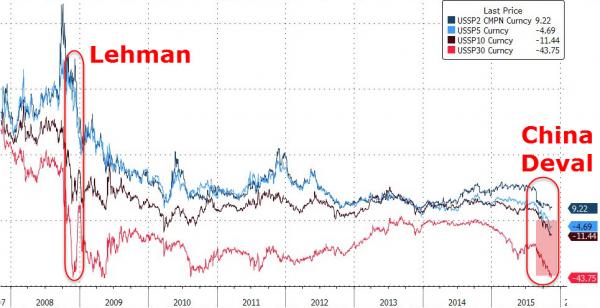By Tyler Durden at ZeroHedge
In the last few months we have warned of the “perversions” in US money markets (here, here, and most recently here) adding that “to ignore them at your own peril.” And now, as Bloomberg reports, it appears the mainstream is beginning to recognize that something very strange is going on in debt markets. Across developed markets, the conventional relationship between (‘risk-free’) government debt and other ‘more risky’ assets has been turned upside-down. “Everybody in the fixed-income market should care about this,” warns a rates strategist and in fact, it’s hard to overstate how illogical it is when swap spreads are inverted, as JPM warns the moves in swap-spreads “should be viewed as symptomatic of deeper problems.”
As we stated before, a negative swap spread holds no interpretative meaning, the very fact of which is the most important element.
In other words, we don’t have to figure out what the “market” is saying about a negative spread because it isn’t saying anything other than “something” is wrong (and very wrong with so many and deeper negative and compressed maturities).
There are numerous reasons for this “nonsense” – as we detailed here, and as Bloomberg adds,
“These kinds of dislocations can be expected to grow over time,” said Aaron Kohli, a fixed-income strategist at Bank of Montreal, one of 22 primary dealers that trade directly with the Fed. “The market structure and regulatory structure has evolved in a period with very low volatility. Once you take that away, it’s not clear what the secondary implications of that will be.”…
As the phenomenon becomes more widespread, it adds to evidence that it’s not just a one-off, according to Priya Misra, the New York-based head of global interest-rate strategy at TD Securities, another primary dealer.
“Everybody in the fixed-income market should care about this,” she said.
In the U.K., where the Bank of England is also debating whether to raise rates, the swap spread reached minus 0.05 percentage points on Nov. 12, the least since December 2013. The difference between 10-year Australian notes and comparable swaps fell to a record last week as speculation diminished the central bank will cut borrowing costs.
“Traditional pricing and relative-value rules are breaking down,” said David Goodman, head of global capital markets strategy at Westpac Banking Corp.
…
“This is not really just a somewhat esoteric story about interest-rate derivatives,” JPMorgan strategists led by Joshua Younger wrote in a Nov. 6 report. “Moves in spreads should be viewed as symptomatic of deeper problems.”
Another potential problem is that inverted swap spreads may ultimately cause investors and borrowers to lose confidence in the bond market’s ability to correctly price risk and provide capital to those who need it, according to Steve Major, head of fixed income research at HSBC Holdings Plc.
* * *
Alhambra’s Jeffrey Snider detailss,
That presents enormous potential problems for the future outlook in all things “dollar.” Again, with interest rates pinned against ZIRP already and any lingering expectations for a rate hike (or somehow a series of them) can only serve as aggravation on this “demand” side for the math. In terms of economic expectations, the growing sense of recession amounts to the same if not more so as it would continue to adversely impact against credit spreads generally. In other words, by far the most likely modeled path for the future direction of at least pension liability discounting (along with the same in insurance company mechanics) is higher in almost every case – the only one where that wouldn’t be true is where the Fed sticks to “lower for longer” as the economy actually strengthens considerably.From that current midpoint, we can reasonably assume that both sides of the dark leverage imbalance will remain in their current directions; eurodollar dealers keep looking to exit while swap and hedging demand continues to sharpen. The resulting compressing swap spreads thus act as quite visible signal of continuing and further financial irregularity that only reinforces both sides of the trend to begin with – just as 2008. It goes until the imbalance forces a full-scale break, like that of August 24, with widespread and forced systemic rebalancing.
When I wrote back in September that you ignore swap spreads at your own peril, this is one part that I had in mind – but it is not the only channel. Pension funds and insurance companies represent massive, unthinkably so, pools of both assets and offsetting liabilities that are highly, highly attuned to this math absurdity. Negative swap spreads all over the place, and getting more so, tell us that these huge pools are highly perturbed, as those spread “prices” represent the increasing cost (and reduced availability) of hedging against very real liability upset. Such a condition is, quite simply, highly dangerous. Math is money; and where there is less reliable math, there is less money and then geometrically less patience.
Finally, we leave it to Bloomberg to conclude,
The role of the bond market is to provide funding at the right rates for the real economy,” Major said. “That’s why the bond market exists — to help efficiently finance projects, businesses etcetera. If that efficiency is undermined, it’s not going to be a positive thing for the economy.”Whatever the reason, the severity of the distortions is unnerving many investors.
“What there doesn’t appear to be is any single smoking gun that says why swap spread changes have been so dramatic,” said Thomas Urano, a money manager at Sage Advisory Services Ltd., which oversees $11 billion. The big question remains whether there is “something bigger brewing under the surface that so far hasn’t been pinpointed yet.”



